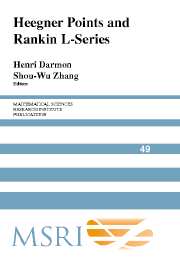Book contents
- Frontmatter
- Contents
- Preface
- Heegner Points: The Beginnings
- Correspondence
- The Gauss Class Number Problem for Imaginary Quadratic Fields
- Heegner Points and Representation Theory
- Gross–Zagier Revisited
- Special Value Formulae for Rankin L-Functions
- Gross-Zagier Formula for GL(2), II
- Special Cycles and Derivatives of Eisenstein Series
- Faltings' Height and the Derivatives of Eisenstein Series
- Elliptic Curves and Analogies Between Number Fields and Function Fields
- Heegner Points and Elliptic Curves of Large Rank over Function Fields
- Periods and Points Attached to Quadratic Algebras
Gross–Zagier Revisited
Published online by Cambridge University Press: 06 July 2010
- Frontmatter
- Contents
- Preface
- Heegner Points: The Beginnings
- Correspondence
- The Gauss Class Number Problem for Imaginary Quadratic Fields
- Heegner Points and Representation Theory
- Gross–Zagier Revisited
- Special Value Formulae for Rankin L-Functions
- Gross-Zagier Formula for GL(2), II
- Special Cycles and Derivatives of Eisenstein Series
- Faltings' Height and the Derivatives of Eisenstein Series
- Elliptic Curves and Analogies Between Number Fields and Function Fields
- Heegner Points and Elliptic Curves of Large Rank over Function Fields
- Periods and Points Attached to Quadratic Algebras
Summary
Introduction
The aim of this paper is to rework the material in Chapter III of Gross and Zagier's “Heegner points and derivatives of L-series” —see [GZ] in the list of references—based on more systematic deformation-theoretic methods, so as to treat all imaginary quadratic fields, all residue characteristics, and all j-invariants on an equal footing. This leads to more conceptual arguments in several places and interpretations for some quantities which appear to otherwise arise out of thin air in [GZ, Ch. III]. For example, the sum in [GZ, Ch. III, Lemma 8.2] arises for us in (9−6), where it is given a deformation-theoretic meaning. Provided the analytic results in [GZ] are proven for even discriminants, the main results in [GZ] would be valid without parity restriction on the discriminant of the imaginary quadratic field. Our order of development of the basic results follows [GZ, Ch. III], but the methods of proof are usually quite different, making much less use of the “numerology” of modular curves.
Here is a summary of the contents. In Section 2 we consider some background issues related to maps among elliptic curves over various bases and horizontal divisors on relative curves over a discrete valuation ring. In Section 3 we provide a brief survey of the Serre–Tate theorem and the Grothendieck existence theorem, since these form the backbone of the deformation-theoretic methods which underlie all subsequent arguments.
- Type
- Chapter
- Information
- Heegner Points and Rankin L-Series , pp. 67 - 164Publisher: Cambridge University PressPrint publication year: 2004
- 18
- Cited by

